Working in partnership in health & social care
VerifiedAdded on 2020/12/31
|12
|3803
|377
AI Summary
Working in Partnership in Health and Social Care INTRODUCTION 1 TASK 11 1.1 Philosophy of working in partnership 1 1.2 Effectiveness of partnership relationships within health & social care 2 TASK 23 2.1 Models of partnership working in health & social care 3 2.2 Current legislation and organisational practices & policiesfor partnership working 5 2.3 Impact of different practices and policies on collaborative working6 TASK 37 3.1 Possible outcomes of working in partnership 7 3.2 Potential barriers to working in partnership7 3.3 Strategies to improve outcomes of partnership working 8
Contribute Materials
Your contribution can guide someone’s learning journey. Share your
documents today.
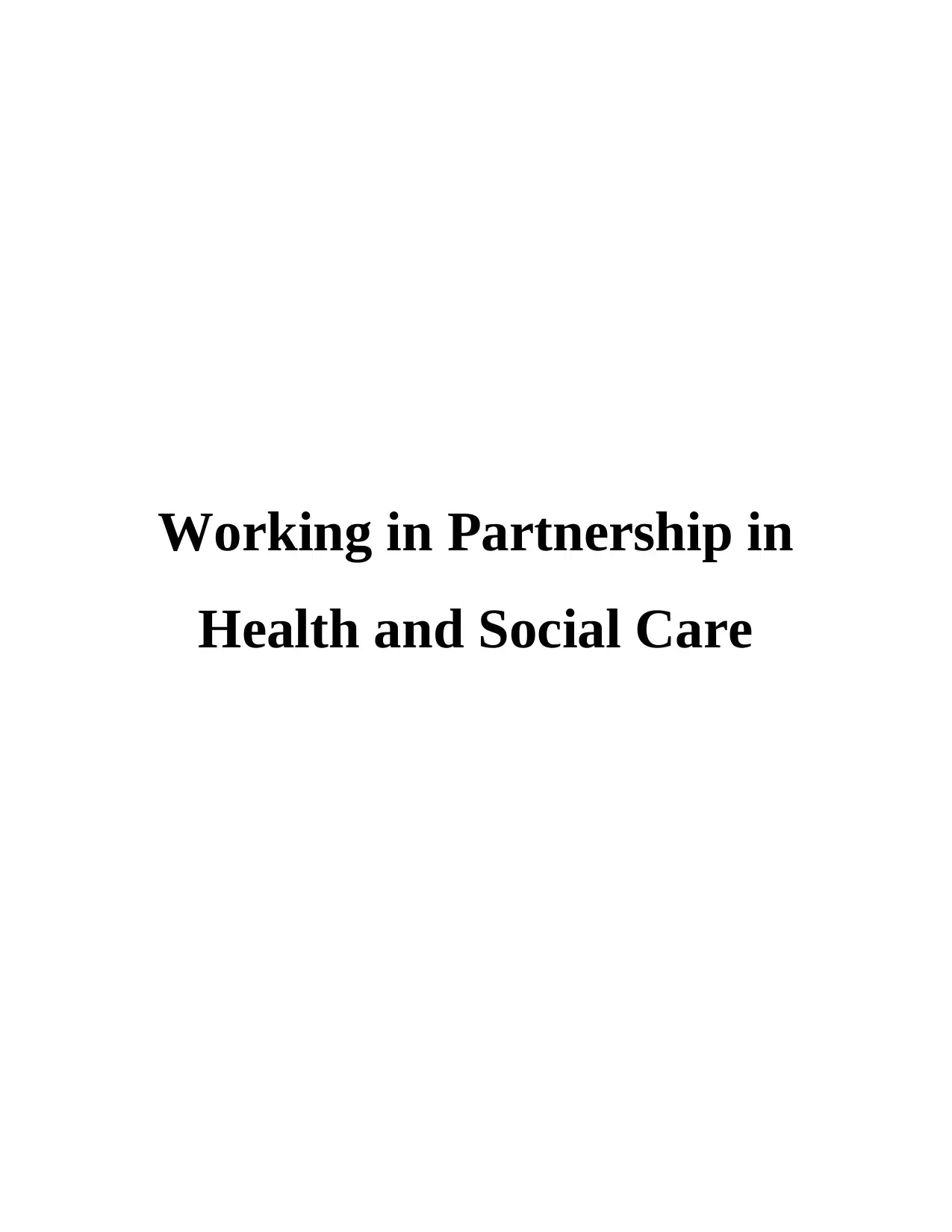
Working in Partnership in
Health and Social Care
Health and Social Care
Secure Best Marks with AI Grader
Need help grading? Try our AI Grader for instant feedback on your assignments.

Table of Contents
INTRODUCTION...........................................................................................................................1
TASK 1 ...........................................................................................................................................1
1.1 Philosophy of working in partnership..............................................................................1
1.2 Effectiveness of partnership relationships within health & social care............................2
TASK 2 ...........................................................................................................................................3
2.1 Models of partnership working in health & social care...................................................3
2.2 Current legislation and organisational practices & policies for partnership working......5
2.3 Impact of different practices and policies on collaborative working...............................6
TASK 3............................................................................................................................................7
3.1 Possible outcomes of working in partnership...................................................................7
3.2 Potential barriers to working in partnership.....................................................................7
3.3 Strategies to improve outcomes of partnership working..................................................8
CONCLUSION................................................................................................................................9
REFERENCES..............................................................................................................................10
INTRODUCTION...........................................................................................................................1
TASK 1 ...........................................................................................................................................1
1.1 Philosophy of working in partnership..............................................................................1
1.2 Effectiveness of partnership relationships within health & social care............................2
TASK 2 ...........................................................................................................................................3
2.1 Models of partnership working in health & social care...................................................3
2.2 Current legislation and organisational practices & policies for partnership working......5
2.3 Impact of different practices and policies on collaborative working...............................6
TASK 3............................................................................................................................................7
3.1 Possible outcomes of working in partnership...................................................................7
3.2 Potential barriers to working in partnership.....................................................................7
3.3 Strategies to improve outcomes of partnership working..................................................8
CONCLUSION................................................................................................................................9
REFERENCES..............................................................................................................................10
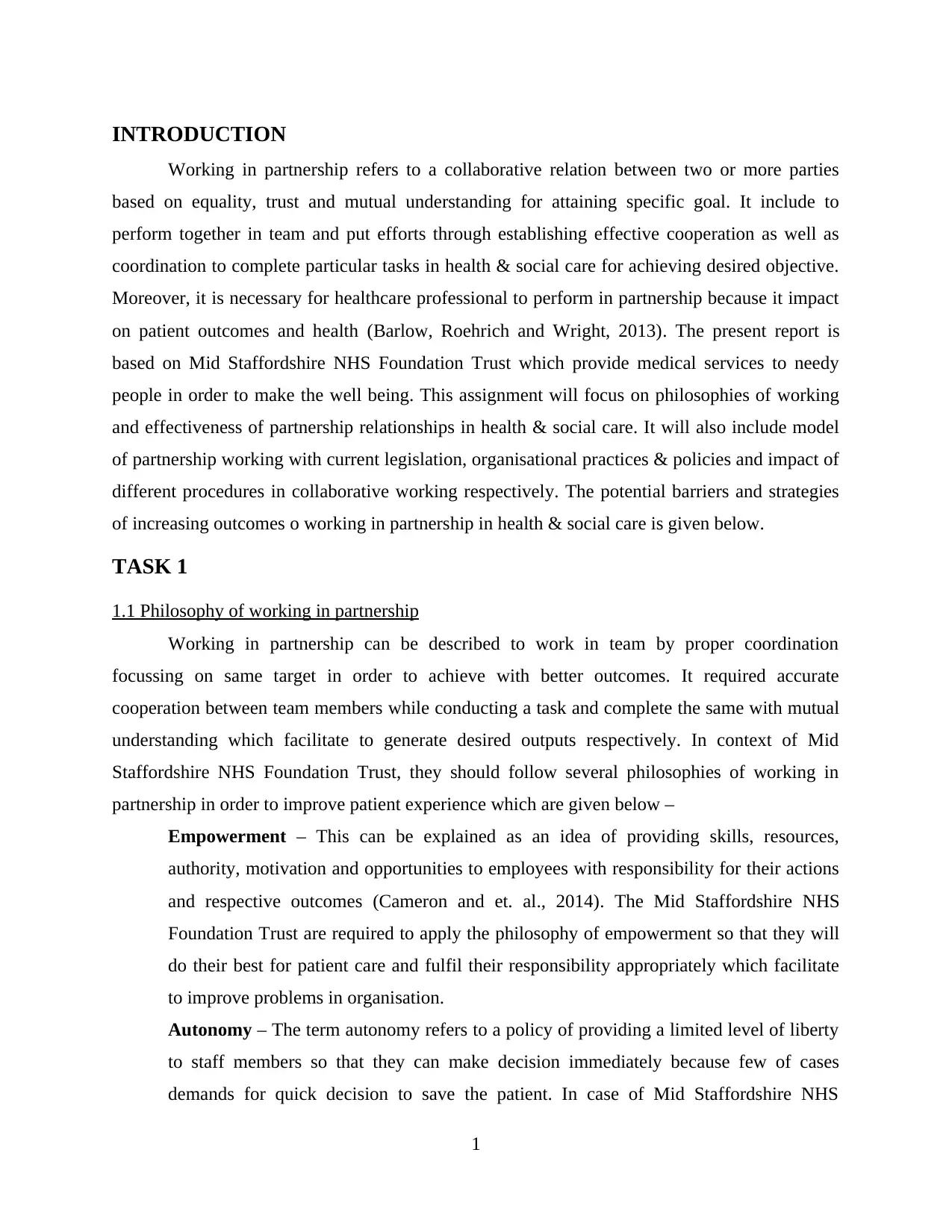
INTRODUCTION
Working in partnership refers to a collaborative relation between two or more parties
based on equality, trust and mutual understanding for attaining specific goal. It include to
perform together in team and put efforts through establishing effective cooperation as well as
coordination to complete particular tasks in health & social care for achieving desired objective.
Moreover, it is necessary for healthcare professional to perform in partnership because it impact
on patient outcomes and health (Barlow, Roehrich and Wright, 2013). The present report is
based on Mid Staffordshire NHS Foundation Trust which provide medical services to needy
people in order to make the well being. This assignment will focus on philosophies of working
and effectiveness of partnership relationships in health & social care. It will also include model
of partnership working with current legislation, organisational practices & policies and impact of
different procedures in collaborative working respectively. The potential barriers and strategies
of increasing outcomes o working in partnership in health & social care is given below.
TASK 1
1.1 Philosophy of working in partnership
Working in partnership can be described to work in team by proper coordination
focussing on same target in order to achieve with better outcomes. It required accurate
cooperation between team members while conducting a task and complete the same with mutual
understanding which facilitate to generate desired outputs respectively. In context of Mid
Staffordshire NHS Foundation Trust, they should follow several philosophies of working in
partnership in order to improve patient experience which are given below –
Empowerment – This can be explained as an idea of providing skills, resources,
authority, motivation and opportunities to employees with responsibility for their actions
and respective outcomes (Cameron and et. al., 2014). The Mid Staffordshire NHS
Foundation Trust are required to apply the philosophy of empowerment so that they will
do their best for patient care and fulfil their responsibility appropriately which facilitate
to improve problems in organisation.
Autonomy – The term autonomy refers to a policy of providing a limited level of liberty
to staff members so that they can make decision immediately because few of cases
demands for quick decision to save the patient. In case of Mid Staffordshire NHS
1
Working in partnership refers to a collaborative relation between two or more parties
based on equality, trust and mutual understanding for attaining specific goal. It include to
perform together in team and put efforts through establishing effective cooperation as well as
coordination to complete particular tasks in health & social care for achieving desired objective.
Moreover, it is necessary for healthcare professional to perform in partnership because it impact
on patient outcomes and health (Barlow, Roehrich and Wright, 2013). The present report is
based on Mid Staffordshire NHS Foundation Trust which provide medical services to needy
people in order to make the well being. This assignment will focus on philosophies of working
and effectiveness of partnership relationships in health & social care. It will also include model
of partnership working with current legislation, organisational practices & policies and impact of
different procedures in collaborative working respectively. The potential barriers and strategies
of increasing outcomes o working in partnership in health & social care is given below.
TASK 1
1.1 Philosophy of working in partnership
Working in partnership can be described to work in team by proper coordination
focussing on same target in order to achieve with better outcomes. It required accurate
cooperation between team members while conducting a task and complete the same with mutual
understanding which facilitate to generate desired outputs respectively. In context of Mid
Staffordshire NHS Foundation Trust, they should follow several philosophies of working in
partnership in order to improve patient experience which are given below –
Empowerment – This can be explained as an idea of providing skills, resources,
authority, motivation and opportunities to employees with responsibility for their actions
and respective outcomes (Cameron and et. al., 2014). The Mid Staffordshire NHS
Foundation Trust are required to apply the philosophy of empowerment so that they will
do their best for patient care and fulfil their responsibility appropriately which facilitate
to improve problems in organisation.
Autonomy – The term autonomy refers to a policy of providing a limited level of liberty
to staff members so that they can make decision immediately because few of cases
demands for quick decision to save the patient. In case of Mid Staffordshire NHS
1
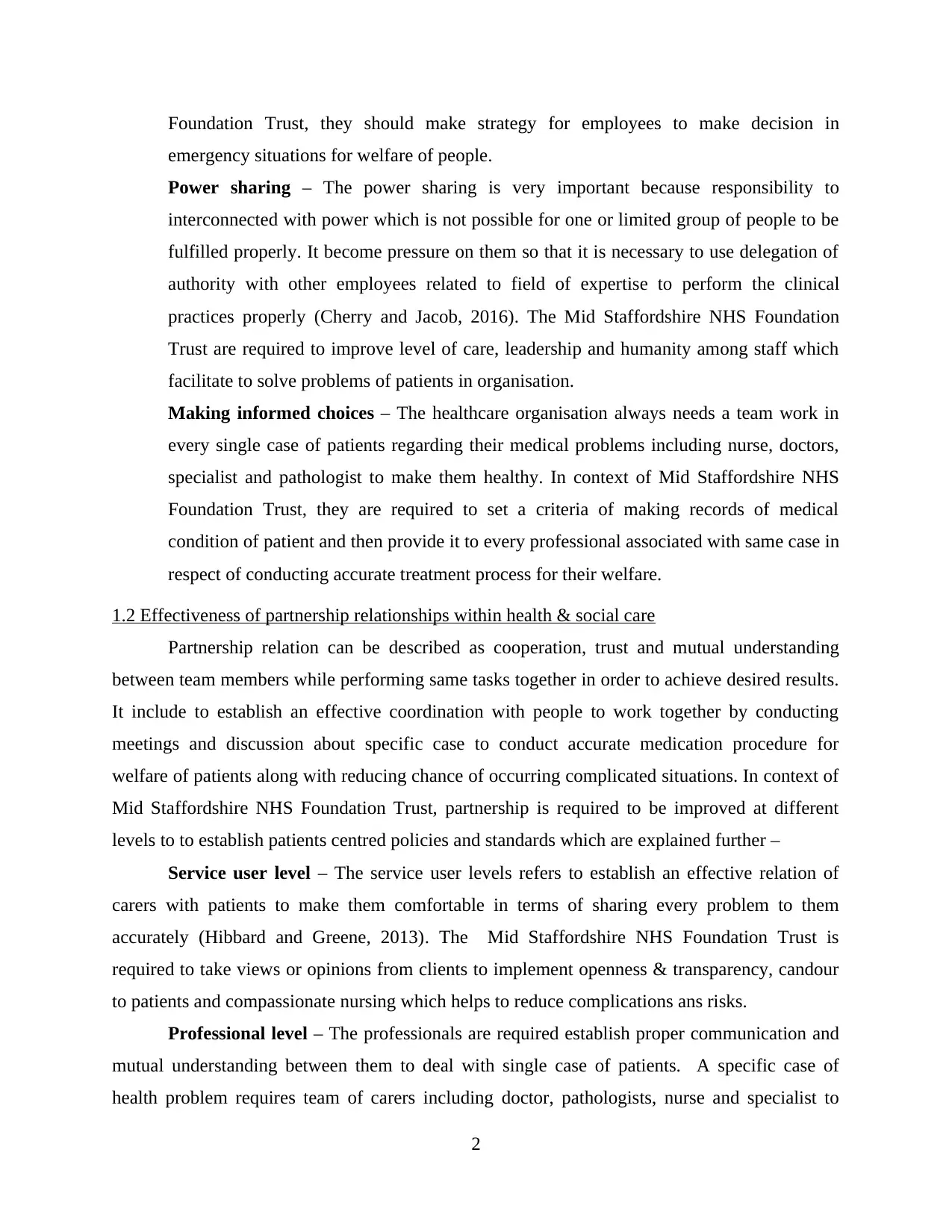
Foundation Trust, they should make strategy for employees to make decision in
emergency situations for welfare of people.
Power sharing – The power sharing is very important because responsibility to
interconnected with power which is not possible for one or limited group of people to be
fulfilled properly. It become pressure on them so that it is necessary to use delegation of
authority with other employees related to field of expertise to perform the clinical
practices properly (Cherry and Jacob, 2016). The Mid Staffordshire NHS Foundation
Trust are required to improve level of care, leadership and humanity among staff which
facilitate to solve problems of patients in organisation.
Making informed choices – The healthcare organisation always needs a team work in
every single case of patients regarding their medical problems including nurse, doctors,
specialist and pathologist to make them healthy. In context of Mid Staffordshire NHS
Foundation Trust, they are required to set a criteria of making records of medical
condition of patient and then provide it to every professional associated with same case in
respect of conducting accurate treatment process for their welfare.
1.2 Effectiveness of partnership relationships within health & social care
Partnership relation can be described as cooperation, trust and mutual understanding
between team members while performing same tasks together in order to achieve desired results.
It include to establish an effective coordination with people to work together by conducting
meetings and discussion about specific case to conduct accurate medication procedure for
welfare of patients along with reducing chance of occurring complicated situations. In context of
Mid Staffordshire NHS Foundation Trust, partnership is required to be improved at different
levels to to establish patients centred policies and standards which are explained further –
Service user level – The service user levels refers to establish an effective relation of
carers with patients to make them comfortable in terms of sharing every problem to them
accurately (Hibbard and Greene, 2013). The Mid Staffordshire NHS Foundation Trust is
required to take views or opinions from clients to implement openness & transparency, candour
to patients and compassionate nursing which helps to reduce complications ans risks.
Professional level – The professionals are required establish proper communication and
mutual understanding between them to deal with single case of patients. A specific case of
health problem requires team of carers including doctor, pathologists, nurse and specialist to
2
emergency situations for welfare of people.
Power sharing – The power sharing is very important because responsibility to
interconnected with power which is not possible for one or limited group of people to be
fulfilled properly. It become pressure on them so that it is necessary to use delegation of
authority with other employees related to field of expertise to perform the clinical
practices properly (Cherry and Jacob, 2016). The Mid Staffordshire NHS Foundation
Trust are required to improve level of care, leadership and humanity among staff which
facilitate to solve problems of patients in organisation.
Making informed choices – The healthcare organisation always needs a team work in
every single case of patients regarding their medical problems including nurse, doctors,
specialist and pathologist to make them healthy. In context of Mid Staffordshire NHS
Foundation Trust, they are required to set a criteria of making records of medical
condition of patient and then provide it to every professional associated with same case in
respect of conducting accurate treatment process for their welfare.
1.2 Effectiveness of partnership relationships within health & social care
Partnership relation can be described as cooperation, trust and mutual understanding
between team members while performing same tasks together in order to achieve desired results.
It include to establish an effective coordination with people to work together by conducting
meetings and discussion about specific case to conduct accurate medication procedure for
welfare of patients along with reducing chance of occurring complicated situations. In context of
Mid Staffordshire NHS Foundation Trust, partnership is required to be improved at different
levels to to establish patients centred policies and standards which are explained further –
Service user level – The service user levels refers to establish an effective relation of
carers with patients to make them comfortable in terms of sharing every problem to them
accurately (Hibbard and Greene, 2013). The Mid Staffordshire NHS Foundation Trust is
required to take views or opinions from clients to implement openness & transparency, candour
to patients and compassionate nursing which helps to reduce complications ans risks.
Professional level – The professionals are required establish proper communication and
mutual understanding between them to deal with single case of patients. A specific case of
health problem requires team of carers including doctor, pathologists, nurse and specialist to
2
Secure Best Marks with AI Grader
Need help grading? Try our AI Grader for instant feedback on your assignments.
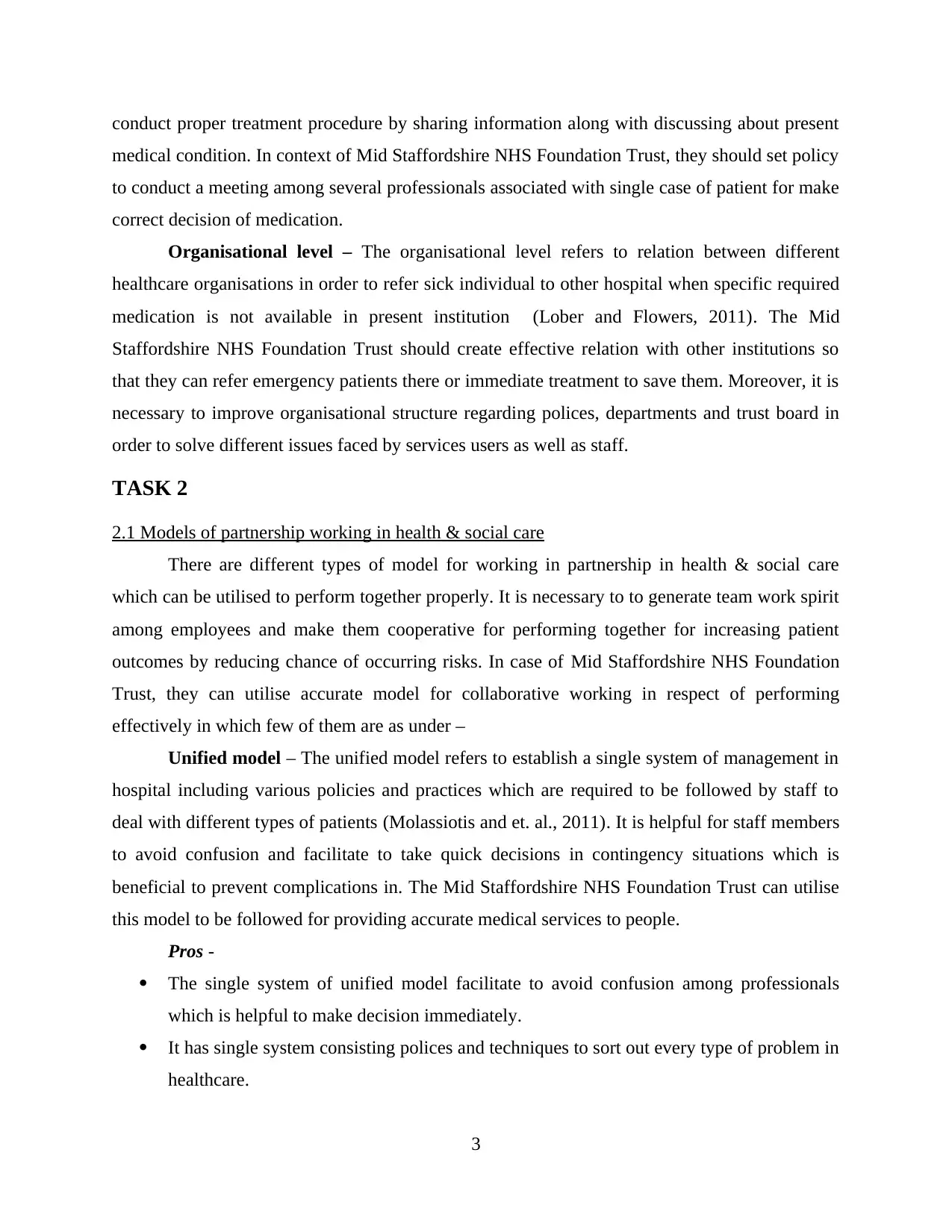
conduct proper treatment procedure by sharing information along with discussing about present
medical condition. In context of Mid Staffordshire NHS Foundation Trust, they should set policy
to conduct a meeting among several professionals associated with single case of patient for make
correct decision of medication.
Organisational level – The organisational level refers to relation between different
healthcare organisations in order to refer sick individual to other hospital when specific required
medication is not available in present institution (Lober and Flowers, 2011). The Mid
Staffordshire NHS Foundation Trust should create effective relation with other institutions so
that they can refer emergency patients there or immediate treatment to save them. Moreover, it is
necessary to improve organisational structure regarding polices, departments and trust board in
order to solve different issues faced by services users as well as staff.
TASK 2
2.1 Models of partnership working in health & social care
There are different types of model for working in partnership in health & social care
which can be utilised to perform together properly. It is necessary to to generate team work spirit
among employees and make them cooperative for performing together for increasing patient
outcomes by reducing chance of occurring risks. In case of Mid Staffordshire NHS Foundation
Trust, they can utilise accurate model for collaborative working in respect of performing
effectively in which few of them are as under –
Unified model – The unified model refers to establish a single system of management in
hospital including various policies and practices which are required to be followed by staff to
deal with different types of patients (Molassiotis and et. al., 2011). It is helpful for staff members
to avoid confusion and facilitate to take quick decisions in contingency situations which is
beneficial to prevent complications in. The Mid Staffordshire NHS Foundation Trust can utilise
this model to be followed for providing accurate medical services to people.
Pros -
The single system of unified model facilitate to avoid confusion among professionals
which is helpful to make decision immediately.
It has single system consisting polices and techniques to sort out every type of problem in
healthcare.
3
medical condition. In context of Mid Staffordshire NHS Foundation Trust, they should set policy
to conduct a meeting among several professionals associated with single case of patient for make
correct decision of medication.
Organisational level – The organisational level refers to relation between different
healthcare organisations in order to refer sick individual to other hospital when specific required
medication is not available in present institution (Lober and Flowers, 2011). The Mid
Staffordshire NHS Foundation Trust should create effective relation with other institutions so
that they can refer emergency patients there or immediate treatment to save them. Moreover, it is
necessary to improve organisational structure regarding polices, departments and trust board in
order to solve different issues faced by services users as well as staff.
TASK 2
2.1 Models of partnership working in health & social care
There are different types of model for working in partnership in health & social care
which can be utilised to perform together properly. It is necessary to to generate team work spirit
among employees and make them cooperative for performing together for increasing patient
outcomes by reducing chance of occurring risks. In case of Mid Staffordshire NHS Foundation
Trust, they can utilise accurate model for collaborative working in respect of performing
effectively in which few of them are as under –
Unified model – The unified model refers to establish a single system of management in
hospital including various policies and practices which are required to be followed by staff to
deal with different types of patients (Molassiotis and et. al., 2011). It is helpful for staff members
to avoid confusion and facilitate to take quick decisions in contingency situations which is
beneficial to prevent complications in. The Mid Staffordshire NHS Foundation Trust can utilise
this model to be followed for providing accurate medical services to people.
Pros -
The single system of unified model facilitate to avoid confusion among professionals
which is helpful to make decision immediately.
It has single system consisting polices and techniques to sort out every type of problem in
healthcare.
3

Cons –
This system may create problems many times because it is not applicable in each critical
situation in hospital.
It generate limitations for professionals so that they are not capable to apply effective
strategy which reduce patient outcomes.
Coalition model – This model consist an appropriate strategy to conduct different
activities which are interlined with each other of particular medication process (Phelan and et.
al., 2015). In context of Mid Staffordshire NHS Foundation Trust, they can utilise this model for
carrying out different events regarding single patient for their well-being. For example,
Computed Tomography (CT) Scan, blood test, medication and surgical process for particular
individual to solve problem of kidney stone.
Pros -
It is helpful to conduct every specific activity properly with better outcomes which is
beneficial for sick person.
It is easy to focus and complete specific activity of treatment procedure which improve
patient experience.
Cons -
This is a time consuming model in terms of making set of activities for particular process.
It may create confusion due to number if activities to be done in correct sequence which
can generate problem in treatment procedure.
Hybrid model – This model refers to establish a combination of two models by
considering suitable strategies in respect of making new model to conduct treatment process
accurately (Powell and et. al., 2012). The Mid Staffordshire NHS Foundation Trust can adopt
this models so it is beneficial to prepare own model to be implemented as per specific situation
of sick individual. It will facilitate to provide an appropriate medication of procedure to make
patient well-being.
Pros –
It provide opportunity to medical professionals for establishing strategies as per situation
which facilitate to solve problems easily.
It is favourable to make combination of models as it is beneficial for patients.
Cons -
4
This system may create problems many times because it is not applicable in each critical
situation in hospital.
It generate limitations for professionals so that they are not capable to apply effective
strategy which reduce patient outcomes.
Coalition model – This model consist an appropriate strategy to conduct different
activities which are interlined with each other of particular medication process (Phelan and et.
al., 2015). In context of Mid Staffordshire NHS Foundation Trust, they can utilise this model for
carrying out different events regarding single patient for their well-being. For example,
Computed Tomography (CT) Scan, blood test, medication and surgical process for particular
individual to solve problem of kidney stone.
Pros -
It is helpful to conduct every specific activity properly with better outcomes which is
beneficial for sick person.
It is easy to focus and complete specific activity of treatment procedure which improve
patient experience.
Cons -
This is a time consuming model in terms of making set of activities for particular process.
It may create confusion due to number if activities to be done in correct sequence which
can generate problem in treatment procedure.
Hybrid model – This model refers to establish a combination of two models by
considering suitable strategies in respect of making new model to conduct treatment process
accurately (Powell and et. al., 2012). The Mid Staffordshire NHS Foundation Trust can adopt
this models so it is beneficial to prepare own model to be implemented as per specific situation
of sick individual. It will facilitate to provide an appropriate medication of procedure to make
patient well-being.
Pros –
It provide opportunity to medical professionals for establishing strategies as per situation
which facilitate to solve problems easily.
It is favourable to make combination of models as it is beneficial for patients.
Cons -
4
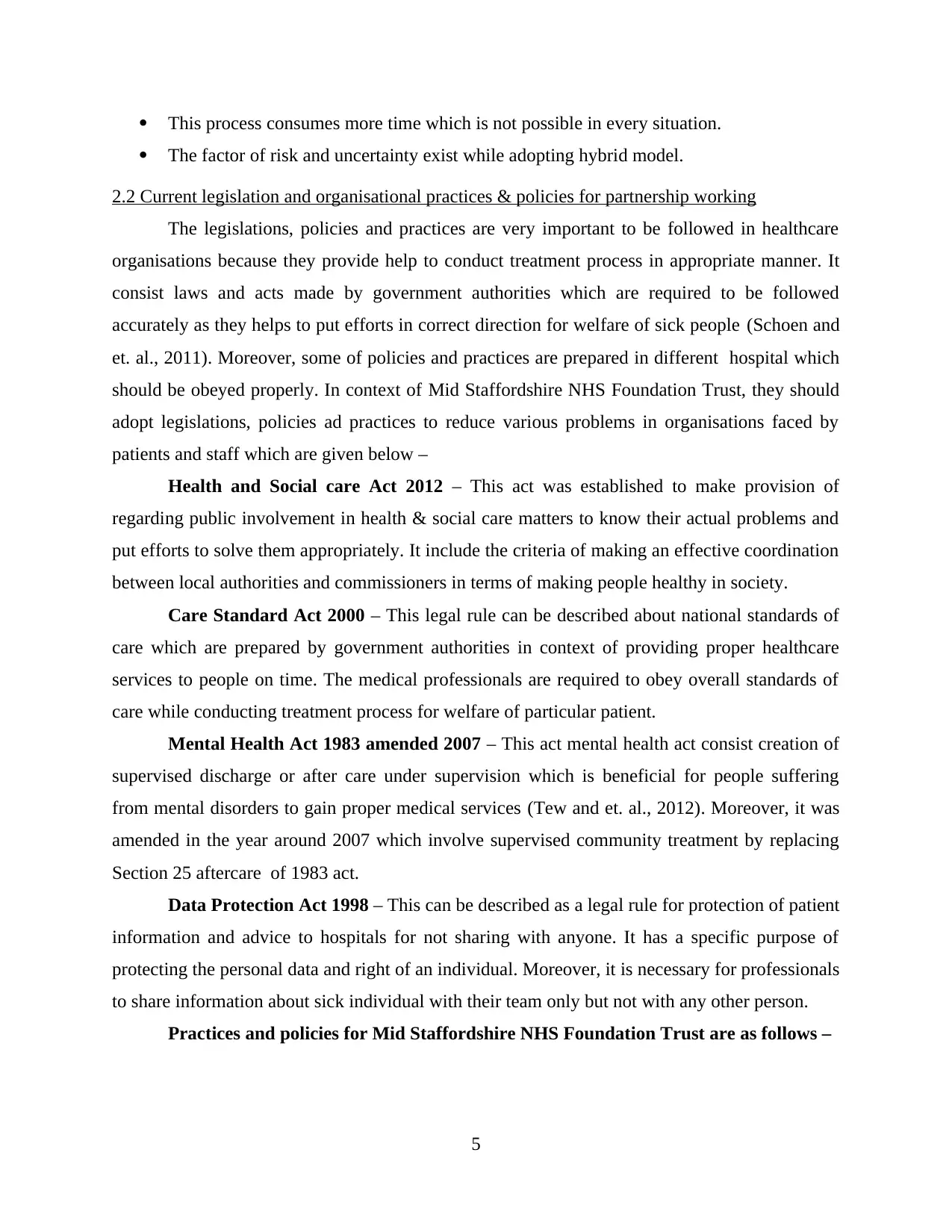
This process consumes more time which is not possible in every situation.
The factor of risk and uncertainty exist while adopting hybrid model.
2.2 Current legislation and organisational practices & policies for partnership working
The legislations, policies and practices are very important to be followed in healthcare
organisations because they provide help to conduct treatment process in appropriate manner. It
consist laws and acts made by government authorities which are required to be followed
accurately as they helps to put efforts in correct direction for welfare of sick people (Schoen and
et. al., 2011). Moreover, some of policies and practices are prepared in different hospital which
should be obeyed properly. In context of Mid Staffordshire NHS Foundation Trust, they should
adopt legislations, policies ad practices to reduce various problems in organisations faced by
patients and staff which are given below –
Health and Social care Act 2012 – This act was established to make provision of
regarding public involvement in health & social care matters to know their actual problems and
put efforts to solve them appropriately. It include the criteria of making an effective coordination
between local authorities and commissioners in terms of making people healthy in society.
Care Standard Act 2000 – This legal rule can be described about national standards of
care which are prepared by government authorities in context of providing proper healthcare
services to people on time. The medical professionals are required to obey overall standards of
care while conducting treatment process for welfare of particular patient.
Mental Health Act 1983 amended 2007 – This act mental health act consist creation of
supervised discharge or after care under supervision which is beneficial for people suffering
from mental disorders to gain proper medical services (Tew and et. al., 2012). Moreover, it was
amended in the year around 2007 which involve supervised community treatment by replacing
Section 25 aftercare of 1983 act.
Data Protection Act 1998 – This can be described as a legal rule for protection of patient
information and advice to hospitals for not sharing with anyone. It has a specific purpose of
protecting the personal data and right of an individual. Moreover, it is necessary for professionals
to share information about sick individual with their team only but not with any other person.
Practices and policies for Mid Staffordshire NHS Foundation Trust are as follows –
5
The factor of risk and uncertainty exist while adopting hybrid model.
2.2 Current legislation and organisational practices & policies for partnership working
The legislations, policies and practices are very important to be followed in healthcare
organisations because they provide help to conduct treatment process in appropriate manner. It
consist laws and acts made by government authorities which are required to be followed
accurately as they helps to put efforts in correct direction for welfare of sick people (Schoen and
et. al., 2011). Moreover, some of policies and practices are prepared in different hospital which
should be obeyed properly. In context of Mid Staffordshire NHS Foundation Trust, they should
adopt legislations, policies ad practices to reduce various problems in organisations faced by
patients and staff which are given below –
Health and Social care Act 2012 – This act was established to make provision of
regarding public involvement in health & social care matters to know their actual problems and
put efforts to solve them appropriately. It include the criteria of making an effective coordination
between local authorities and commissioners in terms of making people healthy in society.
Care Standard Act 2000 – This legal rule can be described about national standards of
care which are prepared by government authorities in context of providing proper healthcare
services to people on time. The medical professionals are required to obey overall standards of
care while conducting treatment process for welfare of particular patient.
Mental Health Act 1983 amended 2007 – This act mental health act consist creation of
supervised discharge or after care under supervision which is beneficial for people suffering
from mental disorders to gain proper medical services (Tew and et. al., 2012). Moreover, it was
amended in the year around 2007 which involve supervised community treatment by replacing
Section 25 aftercare of 1983 act.
Data Protection Act 1998 – This can be described as a legal rule for protection of patient
information and advice to hospitals for not sharing with anyone. It has a specific purpose of
protecting the personal data and right of an individual. Moreover, it is necessary for professionals
to share information about sick individual with their team only but not with any other person.
Practices and policies for Mid Staffordshire NHS Foundation Trust are as follows –
5
Paraphrase This Document
Need a fresh take? Get an instant paraphrase of this document with our AI Paraphraser
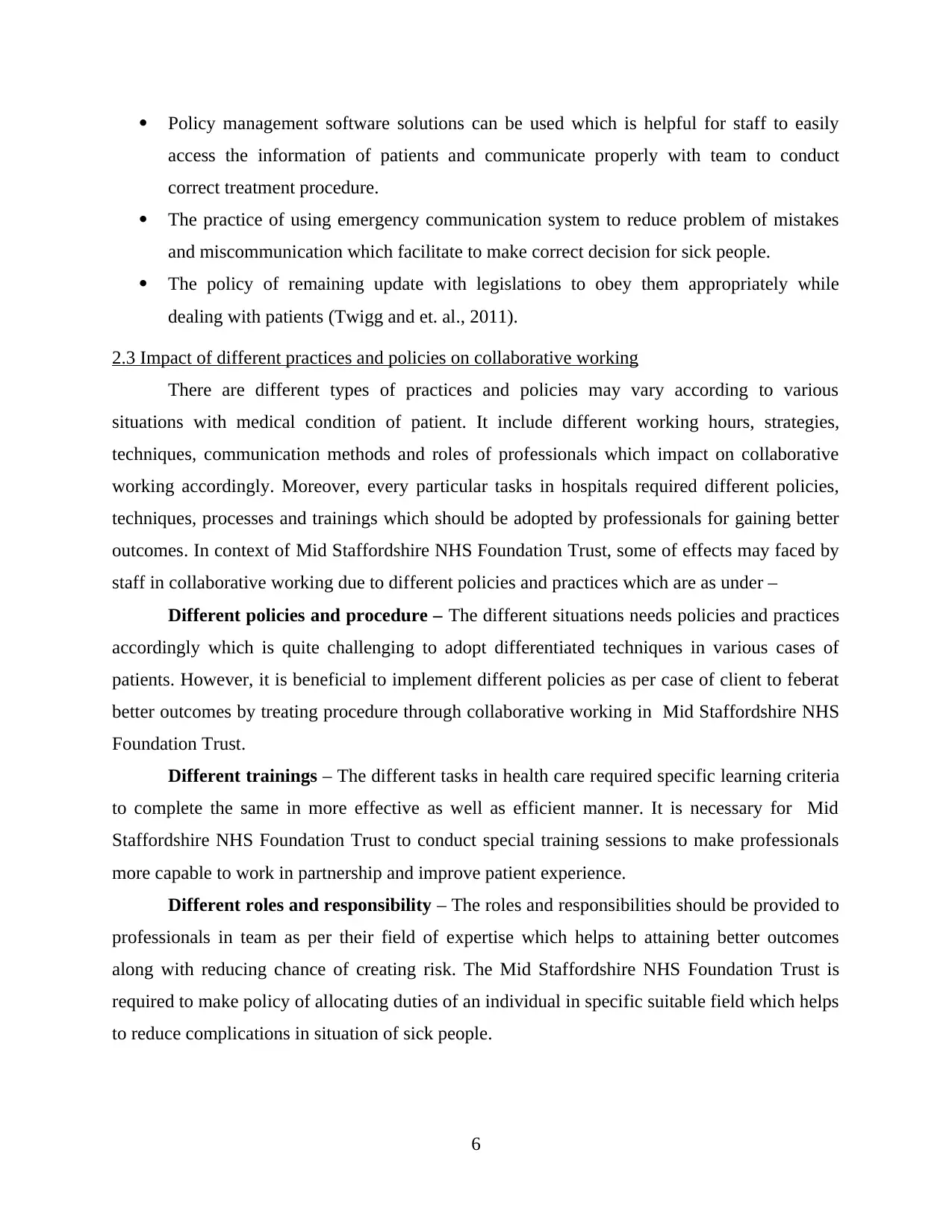
Policy management software solutions can be used which is helpful for staff to easily
access the information of patients and communicate properly with team to conduct
correct treatment procedure.
The practice of using emergency communication system to reduce problem of mistakes
and miscommunication which facilitate to make correct decision for sick people.
The policy of remaining update with legislations to obey them appropriately while
dealing with patients (Twigg and et. al., 2011).
2.3 Impact of different practices and policies on collaborative working
There are different types of practices and policies may vary according to various
situations with medical condition of patient. It include different working hours, strategies,
techniques, communication methods and roles of professionals which impact on collaborative
working accordingly. Moreover, every particular tasks in hospitals required different policies,
techniques, processes and trainings which should be adopted by professionals for gaining better
outcomes. In context of Mid Staffordshire NHS Foundation Trust, some of effects may faced by
staff in collaborative working due to different policies and practices which are as under –
Different policies and procedure – The different situations needs policies and practices
accordingly which is quite challenging to adopt differentiated techniques in various cases of
patients. However, it is beneficial to implement different policies as per case of client to feberat
better outcomes by treating procedure through collaborative working in Mid Staffordshire NHS
Foundation Trust.
Different trainings – The different tasks in health care required specific learning criteria
to complete the same in more effective as well as efficient manner. It is necessary for Mid
Staffordshire NHS Foundation Trust to conduct special training sessions to make professionals
more capable to work in partnership and improve patient experience.
Different roles and responsibility – The roles and responsibilities should be provided to
professionals in team as per their field of expertise which helps to attaining better outcomes
along with reducing chance of creating risk. The Mid Staffordshire NHS Foundation Trust is
required to make policy of allocating duties of an individual in specific suitable field which helps
to reduce complications in situation of sick people.
6
access the information of patients and communicate properly with team to conduct
correct treatment procedure.
The practice of using emergency communication system to reduce problem of mistakes
and miscommunication which facilitate to make correct decision for sick people.
The policy of remaining update with legislations to obey them appropriately while
dealing with patients (Twigg and et. al., 2011).
2.3 Impact of different practices and policies on collaborative working
There are different types of practices and policies may vary according to various
situations with medical condition of patient. It include different working hours, strategies,
techniques, communication methods and roles of professionals which impact on collaborative
working accordingly. Moreover, every particular tasks in hospitals required different policies,
techniques, processes and trainings which should be adopted by professionals for gaining better
outcomes. In context of Mid Staffordshire NHS Foundation Trust, some of effects may faced by
staff in collaborative working due to different policies and practices which are as under –
Different policies and procedure – The different situations needs policies and practices
accordingly which is quite challenging to adopt differentiated techniques in various cases of
patients. However, it is beneficial to implement different policies as per case of client to feberat
better outcomes by treating procedure through collaborative working in Mid Staffordshire NHS
Foundation Trust.
Different trainings – The different tasks in health care required specific learning criteria
to complete the same in more effective as well as efficient manner. It is necessary for Mid
Staffordshire NHS Foundation Trust to conduct special training sessions to make professionals
more capable to work in partnership and improve patient experience.
Different roles and responsibility – The roles and responsibilities should be provided to
professionals in team as per their field of expertise which helps to attaining better outcomes
along with reducing chance of creating risk. The Mid Staffordshire NHS Foundation Trust is
required to make policy of allocating duties of an individual in specific suitable field which helps
to reduce complications in situation of sick people.
6
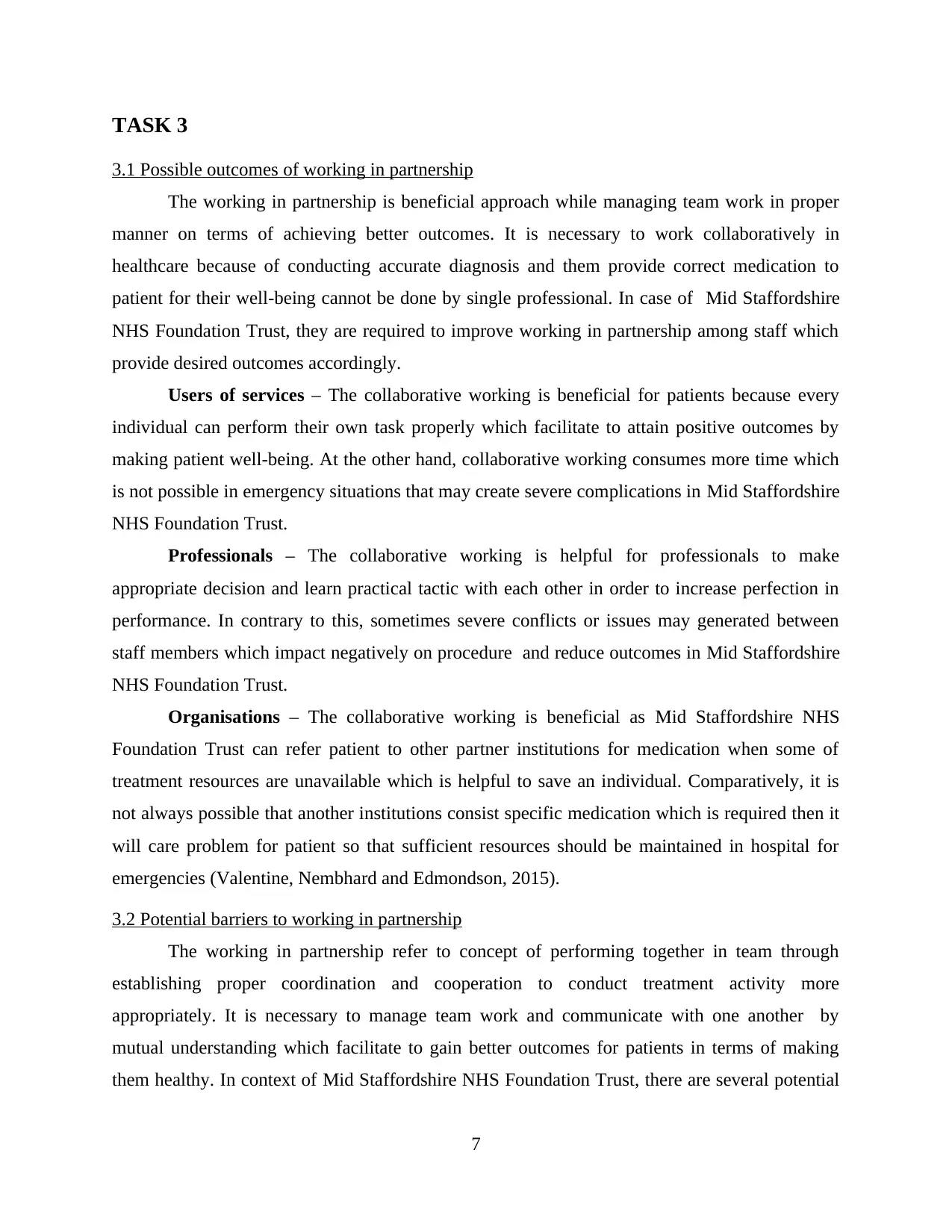
TASK 3
3.1 Possible outcomes of working in partnership
The working in partnership is beneficial approach while managing team work in proper
manner on terms of achieving better outcomes. It is necessary to work collaboratively in
healthcare because of conducting accurate diagnosis and them provide correct medication to
patient for their well-being cannot be done by single professional. In case of Mid Staffordshire
NHS Foundation Trust, they are required to improve working in partnership among staff which
provide desired outcomes accordingly.
Users of services – The collaborative working is beneficial for patients because every
individual can perform their own task properly which facilitate to attain positive outcomes by
making patient well-being. At the other hand, collaborative working consumes more time which
is not possible in emergency situations that may create severe complications in Mid Staffordshire
NHS Foundation Trust.
Professionals – The collaborative working is helpful for professionals to make
appropriate decision and learn practical tactic with each other in order to increase perfection in
performance. In contrary to this, sometimes severe conflicts or issues may generated between
staff members which impact negatively on procedure and reduce outcomes in Mid Staffordshire
NHS Foundation Trust.
Organisations – The collaborative working is beneficial as Mid Staffordshire NHS
Foundation Trust can refer patient to other partner institutions for medication when some of
treatment resources are unavailable which is helpful to save an individual. Comparatively, it is
not always possible that another institutions consist specific medication which is required then it
will care problem for patient so that sufficient resources should be maintained in hospital for
emergencies (Valentine, Nembhard and Edmondson, 2015).
3.2 Potential barriers to working in partnership
The working in partnership refer to concept of performing together in team through
establishing proper coordination and cooperation to conduct treatment activity more
appropriately. It is necessary to manage team work and communicate with one another by
mutual understanding which facilitate to gain better outcomes for patients in terms of making
them healthy. In context of Mid Staffordshire NHS Foundation Trust, there are several potential
7
3.1 Possible outcomes of working in partnership
The working in partnership is beneficial approach while managing team work in proper
manner on terms of achieving better outcomes. It is necessary to work collaboratively in
healthcare because of conducting accurate diagnosis and them provide correct medication to
patient for their well-being cannot be done by single professional. In case of Mid Staffordshire
NHS Foundation Trust, they are required to improve working in partnership among staff which
provide desired outcomes accordingly.
Users of services – The collaborative working is beneficial for patients because every
individual can perform their own task properly which facilitate to attain positive outcomes by
making patient well-being. At the other hand, collaborative working consumes more time which
is not possible in emergency situations that may create severe complications in Mid Staffordshire
NHS Foundation Trust.
Professionals – The collaborative working is helpful for professionals to make
appropriate decision and learn practical tactic with each other in order to increase perfection in
performance. In contrary to this, sometimes severe conflicts or issues may generated between
staff members which impact negatively on procedure and reduce outcomes in Mid Staffordshire
NHS Foundation Trust.
Organisations – The collaborative working is beneficial as Mid Staffordshire NHS
Foundation Trust can refer patient to other partner institutions for medication when some of
treatment resources are unavailable which is helpful to save an individual. Comparatively, it is
not always possible that another institutions consist specific medication which is required then it
will care problem for patient so that sufficient resources should be maintained in hospital for
emergencies (Valentine, Nembhard and Edmondson, 2015).
3.2 Potential barriers to working in partnership
The working in partnership refer to concept of performing together in team through
establishing proper coordination and cooperation to conduct treatment activity more
appropriately. It is necessary to manage team work and communicate with one another by
mutual understanding which facilitate to gain better outcomes for patients in terms of making
them healthy. In context of Mid Staffordshire NHS Foundation Trust, there are several potential
7
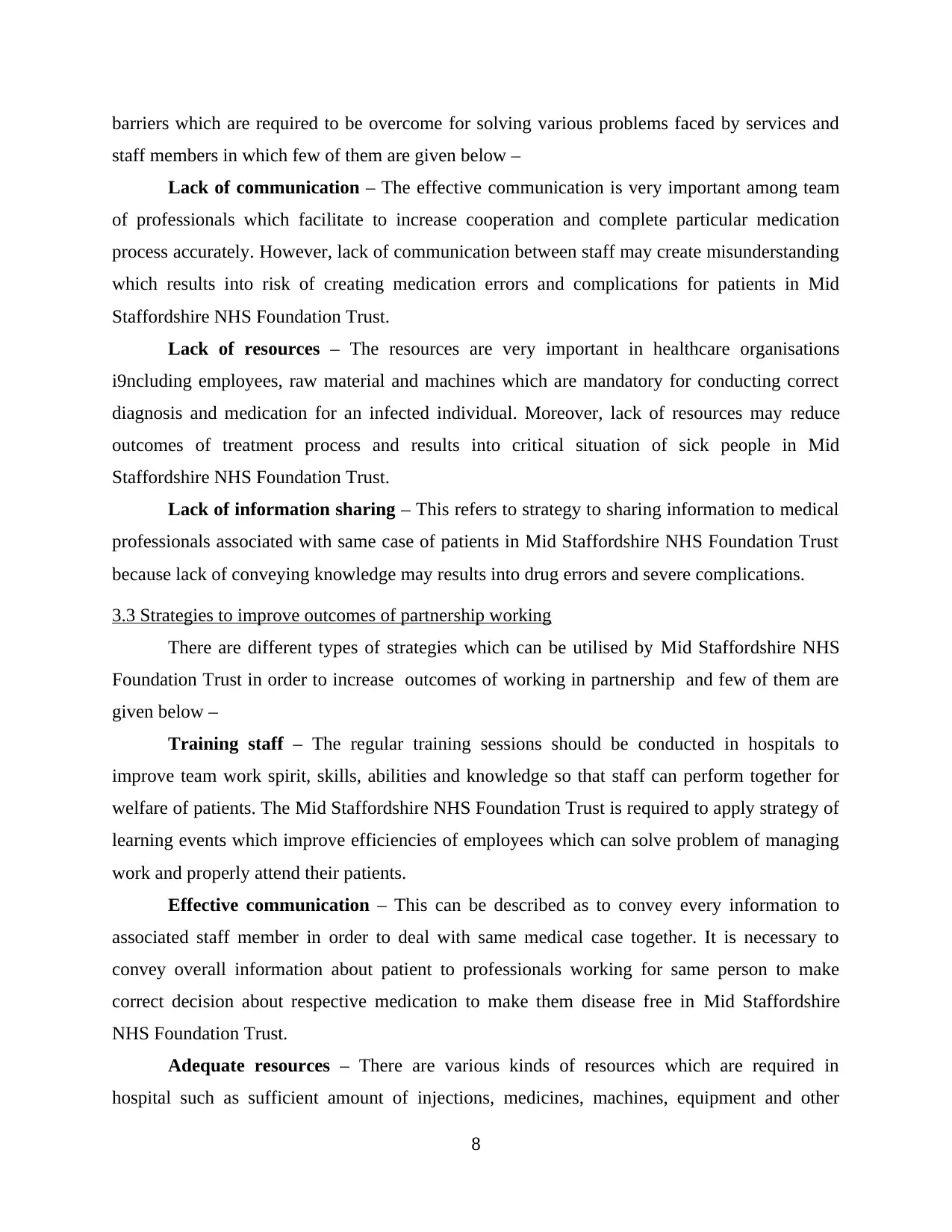
barriers which are required to be overcome for solving various problems faced by services and
staff members in which few of them are given below –
Lack of communication – The effective communication is very important among team
of professionals which facilitate to increase cooperation and complete particular medication
process accurately. However, lack of communication between staff may create misunderstanding
which results into risk of creating medication errors and complications for patients in Mid
Staffordshire NHS Foundation Trust.
Lack of resources – The resources are very important in healthcare organisations
i9ncluding employees, raw material and machines which are mandatory for conducting correct
diagnosis and medication for an infected individual. Moreover, lack of resources may reduce
outcomes of treatment process and results into critical situation of sick people in Mid
Staffordshire NHS Foundation Trust.
Lack of information sharing – This refers to strategy to sharing information to medical
professionals associated with same case of patients in Mid Staffordshire NHS Foundation Trust
because lack of conveying knowledge may results into drug errors and severe complications.
3.3 Strategies to improve outcomes of partnership working
There are different types of strategies which can be utilised by Mid Staffordshire NHS
Foundation Trust in order to increase outcomes of working in partnership and few of them are
given below –
Training staff – The regular training sessions should be conducted in hospitals to
improve team work spirit, skills, abilities and knowledge so that staff can perform together for
welfare of patients. The Mid Staffordshire NHS Foundation Trust is required to apply strategy of
learning events which improve efficiencies of employees which can solve problem of managing
work and properly attend their patients.
Effective communication – This can be described as to convey every information to
associated staff member in order to deal with same medical case together. It is necessary to
convey overall information about patient to professionals working for same person to make
correct decision about respective medication to make them disease free in Mid Staffordshire
NHS Foundation Trust.
Adequate resources – There are various kinds of resources which are required in
hospital such as sufficient amount of injections, medicines, machines, equipment and other
8
staff members in which few of them are given below –
Lack of communication – The effective communication is very important among team
of professionals which facilitate to increase cooperation and complete particular medication
process accurately. However, lack of communication between staff may create misunderstanding
which results into risk of creating medication errors and complications for patients in Mid
Staffordshire NHS Foundation Trust.
Lack of resources – The resources are very important in healthcare organisations
i9ncluding employees, raw material and machines which are mandatory for conducting correct
diagnosis and medication for an infected individual. Moreover, lack of resources may reduce
outcomes of treatment process and results into critical situation of sick people in Mid
Staffordshire NHS Foundation Trust.
Lack of information sharing – This refers to strategy to sharing information to medical
professionals associated with same case of patients in Mid Staffordshire NHS Foundation Trust
because lack of conveying knowledge may results into drug errors and severe complications.
3.3 Strategies to improve outcomes of partnership working
There are different types of strategies which can be utilised by Mid Staffordshire NHS
Foundation Trust in order to increase outcomes of working in partnership and few of them are
given below –
Training staff – The regular training sessions should be conducted in hospitals to
improve team work spirit, skills, abilities and knowledge so that staff can perform together for
welfare of patients. The Mid Staffordshire NHS Foundation Trust is required to apply strategy of
learning events which improve efficiencies of employees which can solve problem of managing
work and properly attend their patients.
Effective communication – This can be described as to convey every information to
associated staff member in order to deal with same medical case together. It is necessary to
convey overall information about patient to professionals working for same person to make
correct decision about respective medication to make them disease free in Mid Staffordshire
NHS Foundation Trust.
Adequate resources – There are various kinds of resources which are required in
hospital such as sufficient amount of injections, medicines, machines, equipment and other
8
Secure Best Marks with AI Grader
Need help grading? Try our AI Grader for instant feedback on your assignments.
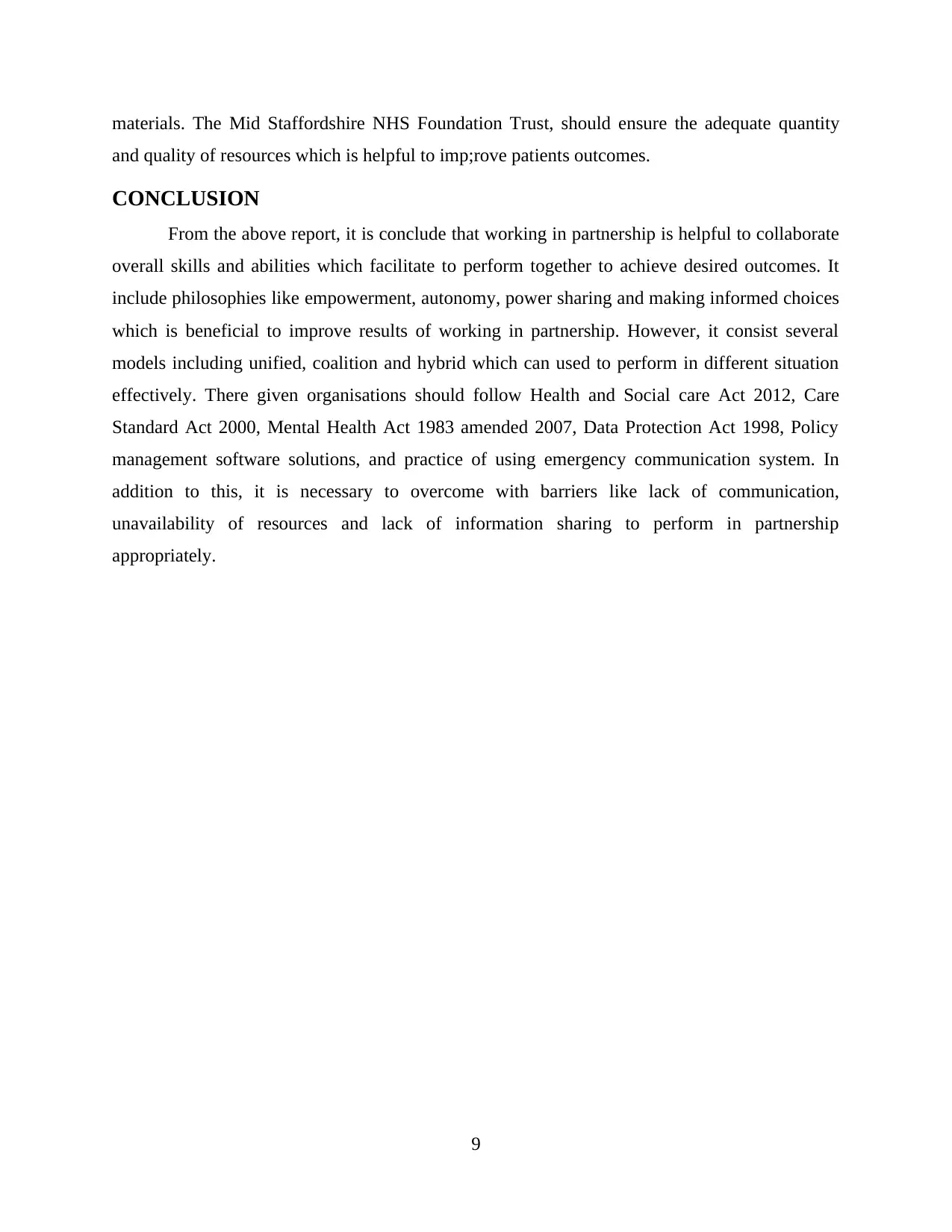
materials. The Mid Staffordshire NHS Foundation Trust, should ensure the adequate quantity
and quality of resources which is helpful to imp;rove patients outcomes.
CONCLUSION
From the above report, it is conclude that working in partnership is helpful to collaborate
overall skills and abilities which facilitate to perform together to achieve desired outcomes. It
include philosophies like empowerment, autonomy, power sharing and making informed choices
which is beneficial to improve results of working in partnership. However, it consist several
models including unified, coalition and hybrid which can used to perform in different situation
effectively. There given organisations should follow Health and Social care Act 2012, Care
Standard Act 2000, Mental Health Act 1983 amended 2007, Data Protection Act 1998, Policy
management software solutions, and practice of using emergency communication system. In
addition to this, it is necessary to overcome with barriers like lack of communication,
unavailability of resources and lack of information sharing to perform in partnership
appropriately.
9
and quality of resources which is helpful to imp;rove patients outcomes.
CONCLUSION
From the above report, it is conclude that working in partnership is helpful to collaborate
overall skills and abilities which facilitate to perform together to achieve desired outcomes. It
include philosophies like empowerment, autonomy, power sharing and making informed choices
which is beneficial to improve results of working in partnership. However, it consist several
models including unified, coalition and hybrid which can used to perform in different situation
effectively. There given organisations should follow Health and Social care Act 2012, Care
Standard Act 2000, Mental Health Act 1983 amended 2007, Data Protection Act 1998, Policy
management software solutions, and practice of using emergency communication system. In
addition to this, it is necessary to overcome with barriers like lack of communication,
unavailability of resources and lack of information sharing to perform in partnership
appropriately.
9
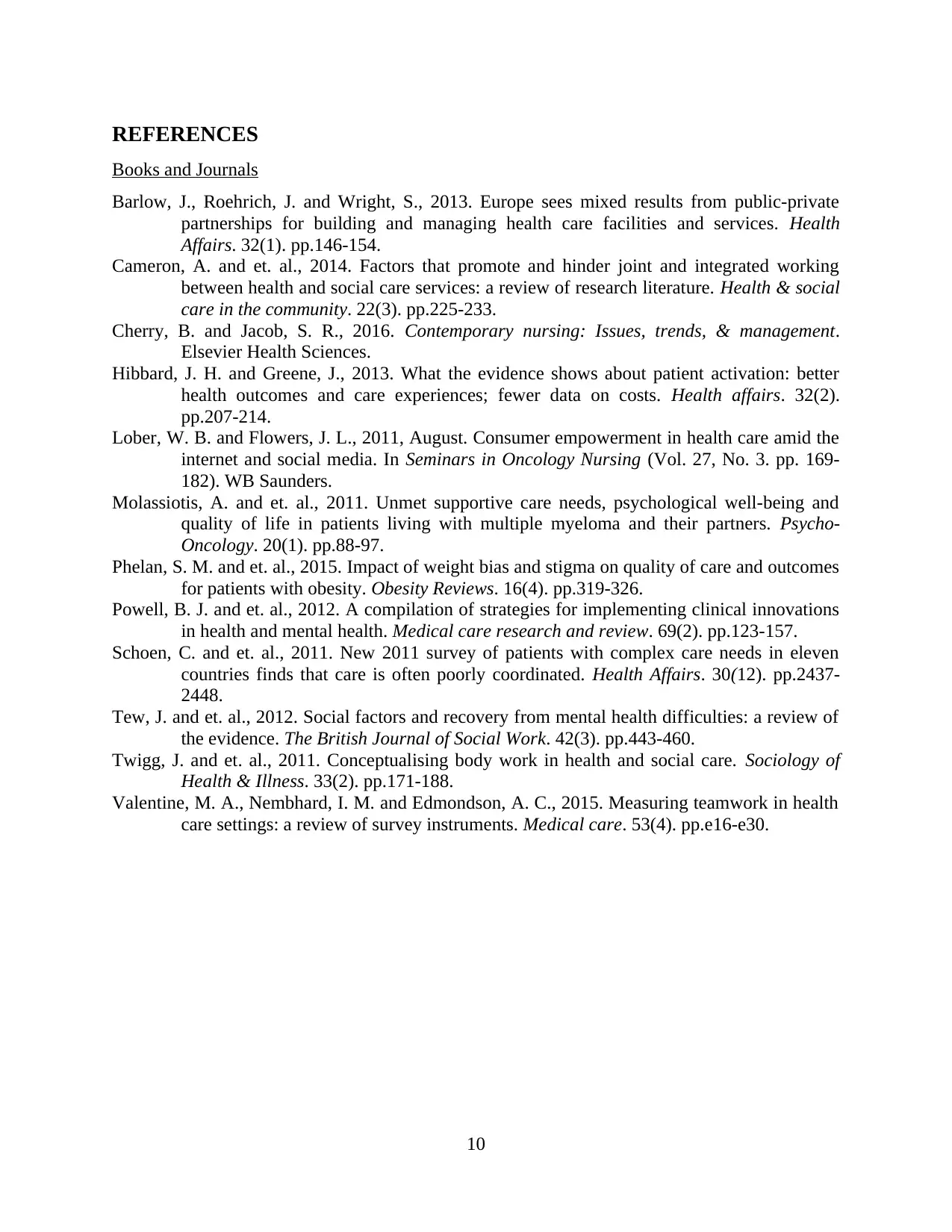
REFERENCES
Books and Journals
Barlow, J., Roehrich, J. and Wright, S., 2013. Europe sees mixed results from public-private
partnerships for building and managing health care facilities and services. Health
Affairs. 32(1). pp.146-154.
Cameron, A. and et. al., 2014. Factors that promote and hinder joint and integrated working
between health and social care services: a review of research literature. Health & social
care in the community. 22(3). pp.225-233.
Cherry, B. and Jacob, S. R., 2016. Contemporary nursing: Issues, trends, & management.
Elsevier Health Sciences.
Hibbard, J. H. and Greene, J., 2013. What the evidence shows about patient activation: better
health outcomes and care experiences; fewer data on costs. Health affairs. 32(2).
pp.207-214.
Lober, W. B. and Flowers, J. L., 2011, August. Consumer empowerment in health care amid the
internet and social media. In Seminars in Oncology Nursing (Vol. 27, No. 3. pp. 169-
182). WB Saunders.
Molassiotis, A. and et. al., 2011. Unmet supportive care needs, psychological well‐being and
quality of life in patients living with multiple myeloma and their partners. Psycho‐
Oncology. 20(1). pp.88-97.
Phelan, S. M. and et. al., 2015. Impact of weight bias and stigma on quality of care and outcomes
for patients with obesity. Obesity Reviews. 16(4). pp.319-326.
Powell, B. J. and et. al., 2012. A compilation of strategies for implementing clinical innovations
in health and mental health. Medical care research and review. 69(2). pp.123-157.
Schoen, C. and et. al., 2011. New 2011 survey of patients with complex care needs in eleven
countries finds that care is often poorly coordinated. Health Affairs. 30(12). pp.2437-
2448.
Tew, J. and et. al., 2012. Social factors and recovery from mental health difficulties: a review of
the evidence. The British Journal of Social Work. 42(3). pp.443-460.
Twigg, J. and et. al., 2011. Conceptualising body work in health and social care. Sociology of
Health & Illness. 33(2). pp.171-188.
Valentine, M. A., Nembhard, I. M. and Edmondson, A. C., 2015. Measuring teamwork in health
care settings: a review of survey instruments. Medical care. 53(4). pp.e16-e30.
10
Books and Journals
Barlow, J., Roehrich, J. and Wright, S., 2013. Europe sees mixed results from public-private
partnerships for building and managing health care facilities and services. Health
Affairs. 32(1). pp.146-154.
Cameron, A. and et. al., 2014. Factors that promote and hinder joint and integrated working
between health and social care services: a review of research literature. Health & social
care in the community. 22(3). pp.225-233.
Cherry, B. and Jacob, S. R., 2016. Contemporary nursing: Issues, trends, & management.
Elsevier Health Sciences.
Hibbard, J. H. and Greene, J., 2013. What the evidence shows about patient activation: better
health outcomes and care experiences; fewer data on costs. Health affairs. 32(2).
pp.207-214.
Lober, W. B. and Flowers, J. L., 2011, August. Consumer empowerment in health care amid the
internet and social media. In Seminars in Oncology Nursing (Vol. 27, No. 3. pp. 169-
182). WB Saunders.
Molassiotis, A. and et. al., 2011. Unmet supportive care needs, psychological well‐being and
quality of life in patients living with multiple myeloma and their partners. Psycho‐
Oncology. 20(1). pp.88-97.
Phelan, S. M. and et. al., 2015. Impact of weight bias and stigma on quality of care and outcomes
for patients with obesity. Obesity Reviews. 16(4). pp.319-326.
Powell, B. J. and et. al., 2012. A compilation of strategies for implementing clinical innovations
in health and mental health. Medical care research and review. 69(2). pp.123-157.
Schoen, C. and et. al., 2011. New 2011 survey of patients with complex care needs in eleven
countries finds that care is often poorly coordinated. Health Affairs. 30(12). pp.2437-
2448.
Tew, J. and et. al., 2012. Social factors and recovery from mental health difficulties: a review of
the evidence. The British Journal of Social Work. 42(3). pp.443-460.
Twigg, J. and et. al., 2011. Conceptualising body work in health and social care. Sociology of
Health & Illness. 33(2). pp.171-188.
Valentine, M. A., Nembhard, I. M. and Edmondson, A. C., 2015. Measuring teamwork in health
care settings: a review of survey instruments. Medical care. 53(4). pp.e16-e30.
10
1 out of 12
Related Documents
Your All-in-One AI-Powered Toolkit for Academic Success.
+13062052269
info@desklib.com
Available 24*7 on WhatsApp / Email
![[object Object]](/_next/static/media/star-bottom.7253800d.svg)
Unlock your academic potential
© 2024 | Zucol Services PVT LTD | All rights reserved.





